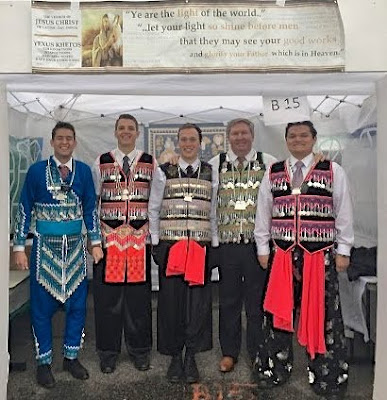A couple of times I have
referenced the Hmong people that our mission serves. We have four missionaries who speak some
Hmong. In February there will be four
more. Sometimes there are two Hmong
speaking missionaries together and sometimes they are divided so an English
speaking elder is with a Hmong speaking elder.
I am fascinated by this
third language in our mission and have spent time asking missionaries questions
and reading online. This is what I learned:
Hmong people historically split off from one of the (approximately 3
dozen) ethnic groups in China, where millions still live. They settled in mountainous
areas of countries such as Thailand and Laos. Some were
resettled in the U. S. beginning around
1970, toward the end of the Viet Nam war. Hmong
immigrants achieved refugee status largely because of their war efforts on behalf of the Americans as well as their need to escape the communist regime in
Laos.
The only city in the U.S.
that has more Hmong people than Fresno is Minneapolis-St.Paul.(~66,000 in MN in
2010) California has the highest Hmong
population among the states (~91,000 in 2010) and Fresno has the highest
population of any city in CA. (around 40,000 now?) There are also several thousand in Merced,
which is in our mission. Immigration has
been fairly limited for years, but Hmongs also increase because they have
larger than average families.
Hmong students took longer to learn English and to
seek higher education than other immigrant groups due to having parents who
spoke little English. In addition, until the French became involved in the
1960s no written form of the Hmong language existed, and many of the Hmong
people were unable to read or write their own language.
The lack of formal education among Hmong immigrants is
also due to the fact that many were once farmers in the hills of Laos or were refugees from war who fled into remote
jungles, and had little or no access to schools. More than 30% of Hmong families in the United
States live under the poverty level. They have struggled with high incidence of
mental health problems, which have been attributed to traumatic past
experiences and problems adjusting to life in the United States. Things are so
very different here and important passages such as death – which, in their
pasts, meant a week long funeral beginning immediately after someone’s demise,
are simply impossible and in some ways, illegal here.
Now many Hmong Americans are rapidly blending into
mainstream American society. Primarily, the older people are the ones who speak
Hmong. The younger people very often make little effort to learn or understand
the language. This is causing some of the younger generation to lose aspects of
their cultural identity at a faster pace. For example, Hmong New Year used to
be a major family event of several days – a celebration with aspects of family
reunions and opportunites to meet extended family. Young people in the U.S. often now use it as
an event to take a date, or go with friends.
Marriage outside their ethnic group is increasing.
In the Hmong
community there have traditionally been values of honoring age and
education. Missionaries who learn the
language gain some acceptance because of the efforts they make to communicate
in Hmong. According to some missionaries, learning the language also helps them
learn the culture and understand the Hmong ways of thinking. They love the Hmong people and are very glad
for the opportunity to get to know them well, to serve them, and to teach them spiritual
truths that can make their lives better.
